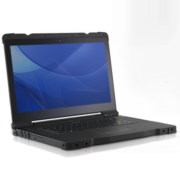“What a rip off! All you do is add is a few cents worth of rubber guards to your corners and call it rugged. The CPU of your rugged laptop is at least 2 years out of date. My regular old civilian laptop does a thousand things your laptop doesn’t. And rugged laptops are heavy, oversized monstrosities! How can you justify your ridiculous price?”
– Not an actual email from a not real customer.
Fortunately, the above fictitious email is not representative of our clients and partners. Most of the people with whom we deal understand the true worth of ruggedized computers. Every once in awhile we run into someone who is new to ruggedness and we have to sit down and explain the facts of life to them.
- “…all you do is add is a few cents worth of rubber guards to your corners.”
Actually, we do a lot more than that. AMREL’s computers are built rugged from the ground up. Most of the work that goes into them is not readily visible.
For example, AMREL laptops have a Fault Tolerant Isolation Design – an encapsulation process that protects individual components from water, dust, and other foreign matter. Analogous to a submarine, each chamber in the body of our laptops and on-board/fixed vehicle units is individually sealed. Protective chambers separate the following compartments: motherboard, I/O ports, removable hard drive, and swappable Application Modules.
Bear in mind that our rugged computers are not just built for getting knocked around. They have to meet exacting standards for operating in high/low pressure, rain, dust, humidity, salt fog, and extreme temperatures. This is one reason that “protective sleeves,” which promise to ruggedize your commercial computer are less than ideal.
- “The CPU of your rugged laptop is at least 2 years out of date. My regular old civilian laptop does a thousand things your laptop doesn’t.”
This is a criticism often leveled at technology fielded by the military, and that is not a coincidence. Many of the same factors that affect the military also affect us.
For example, the rugged computer market is much smaller than the commercial one, just as the military market is lesser than the consumer one. Not only does the lack of economy of scale mean we have to pay higher prices for specialized parts, but the lack of choice for vendors leads to uncontrollable delays. Delays lead to a longer development process, which hinders our ability to utilize the most recent technological advances.
Furthermore, ruggedized computers are used in critical applications for soldiers and police. We build computers as if someone’s life depended on it, because they often do. This leads to a quality control system that is far more strict and redundant than what commercial products are subjected to. To maintain such high standards, delays are inevitable.
So, our product development cycle, like all rugged computer manufacturers, is much longer. Greater and lengthier analyses and tests are required. Under these conditions, it’s almost impossible for any rugged computer to match the latest consumer products with their much shorter development cycles.
Still, AMREL is very conscious of the gap between the latest commercial products and typical ruggedized computers. The good news is that while it still is a problem, we have made real progress in bringing up-to-date technology to the rugged world.
One approach that we have taken is to design our rugged computers to be extremely flexible. Unlike commercial mobile platforms, ours are built to be quickly customized. Adding new technology is easy and convenient.
- “… how can you justify your ridiculous price?
As mention above rugged computers do not enjoy the same economy of scale as commercial ones.
However, this is a bit misleading, because rugged computers are a very good value for their price. This has been confirmed by every study that’s ever investigated this issue. The most well-known is by VDC Research who concluded that “Ruggedized Devices – both large and small form factor – achieve a distinct TCO advantage.”
TCO is Total Cost of Ownership. Not only does it include the initial price, but also platform support, integration, connectivity, lost work time, lost data, repair, and replacement cost. The later factors can be much greater than the initial price.
Another way of phrasing this is that rugged computers break down less often, need less repair, and last much longer than commercial grade ones. I don’t know about you, but whenever my commercial laptop gets over 4 years old, my repair man stars muttering ominous threats about his inability to get “ancient” parts, and how my motherboard won’t support the latest application or operating system. In contrast I know of one police department that has been using our laptops 7 days a week for 12 years. This sort of longevity is especially important to the military.
So complaining that rugged computers are more expensive than commercial ones is the same as comparing a 90-minute phone card with a 45-minute one, i.e. one is more expensive, but it lasts much longer.
- “And rugged laptops are heavy, oversized monstrosities!”
You haven’t been paying attention. AMREL has launched SlimLine, a new generation of extremely thin fully rugged laptops, tablets, and handhelds. They so radically change the conventional idea of durability, that one of our biggest problems is convincing our clients and partners that a laptop only an inch thick is actually fully rugged! We even have a rugged handheld that will run full Windows OS, but is so small that it will slide into a cargo pocket.
Still rugged mobile computers are not for everyone. You should NOT buy a rugged computer if:
- The data on your computer is not important, i.e. you don’t mind loosing it due to failure.
- Frequent downtimes and repairs are not a problem for you.
- You don’t care that you have to replace your handheld, laptop or tablet every few years.
- You operate your computer in an exceptionally stable, non-threatening environment.
If the above statements do not describe you, give one our experts a call at (800) 882-6735, or email us at cdinfo@amrel.com and learn more about the advantages of rugged computers.















